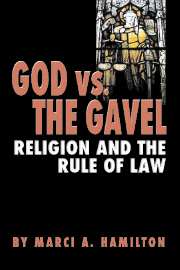Book contents
- Frontmatter
- Contents
- Acknowledgments
- Foreword, by the Hon. Edward R. Becker
- GOD VS. THE GAVEL: RELIGION AND THE RULE OF LAW
- PART ONE WHY THE LAW MUST GOVERN RELIGIOUS ENTITIES
- 1 The Problem
- 2 Children
- 3 Marriage
- 4 Religious Land Use and Residential Neighborhoods
- 5 Schools
- 6 The Prisons and the Military
- 7 Discrimination
- PART TWO THE HISTORY AND DOCTRINE BEHIND THE RULE THAT SUBJECTS RELIGIOUS ENTITIES TO DULY ENACTED LAWS
- Epilogue
- Notes
- Index
2 - Children
Published online by Cambridge University Press: 24 July 2009
- Frontmatter
- Contents
- Acknowledgments
- Foreword, by the Hon. Edward R. Becker
- GOD VS. THE GAVEL: RELIGION AND THE RULE OF LAW
- PART ONE WHY THE LAW MUST GOVERN RELIGIOUS ENTITIES
- 1 The Problem
- 2 Children
- 3 Marriage
- 4 Religious Land Use and Residential Neighborhoods
- 5 Schools
- 6 The Prisons and the Military
- 7 Discrimination
- PART TWO THE HISTORY AND DOCTRINE BEHIND THE RULE THAT SUBJECTS RELIGIOUS ENTITIES TO DULY ENACTED LAWS
- Epilogue
- Notes
- Index
Summary
Warning: If this chapter were a movie, it would have an NC-17 rating, because it describes horrible things that have been done to children beneath the cloak of religion in the United States. Children have been raped, beaten, and permitted to die excruciating deaths.
Young people are at risk from religious adults and institutions in two ways: (1) through the misuse of religious power to abuse the child; or (2) through their parents' religiously motivated medical neglect or physical abuse. The suffering is often unimaginable, because the children lack the ability to protect themselves from death, permanent disability, or severe abuse – at the hands of those they have been taught are here on earth to care for them.
In the first instance, some clergy, day-care providers, and religious schoolteachers use their position to take advantage of children. No person can be trusted to hold power without some check on it, and that is why we have the law – to protect the vulnerable from harm and to preserve the common good. The religious authority figure can be the most outwardly religious and pious individual, but without the law's ability to make the person accountable, he or she is capable of physical and spiritual murder. It is not just a wolf – but a lion – in sheep's clothing. Oftentimes this power-based abuse takes the form of sexual abuse, and sometimes it is physical abuse or ritualistic abuse.
- Type
- Chapter
- Information
- God vs. the GavelReligion and the Rule of Law, pp. 12 - 49Publisher: Cambridge University PressPrint publication year: 2005



